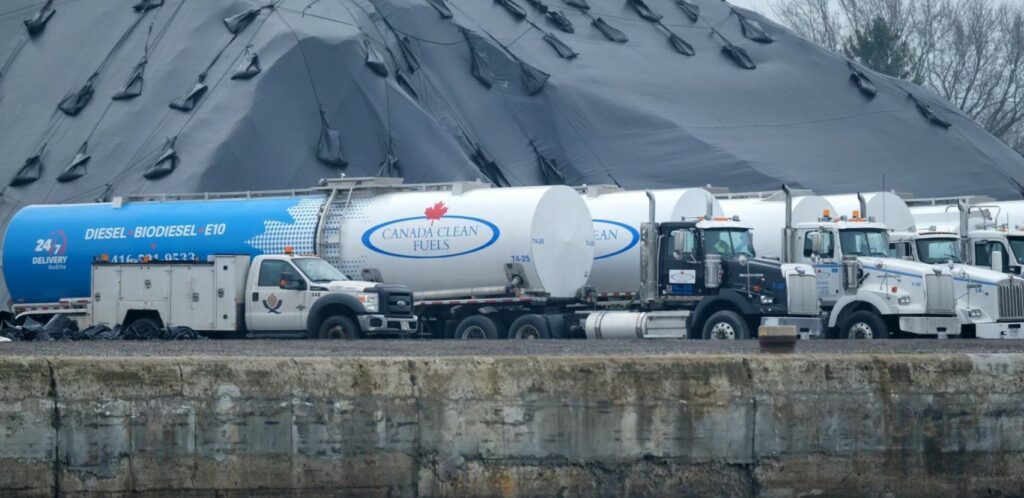Source: The Standard
Port Colborne is to become home to a $33-million, eight-million-litre biofuel terminal that will serve more than 100 vessels annually.
It will sit on five hectares of land on the east pier of the Welland Canal, be managed by Hamilton-Oshawa Port Authority (HOPA) and operated in partnership with Canada Clean Fuels and Canada Steamship Lines (CSL).
On Tuesday, Niagara Centre Liberal MP Vance Badawey, parliamentary secretary to the transport minister, Ian Hamilton, HOPA president and chief executive officer, and Port Colborne Mayor Bill Steele made the announcement in a parking lot near the waterfront.
Badawey said the federal government is investing $13.8 million in the terminal through its green shipping corridor program, established in 2023 to fund technology, equipment and infrastructure that reduces emissions and creates a greener marine sector.
The program funds industry-led investments, on vessels and onshore, through two streams.
One is a $22.5-million clean vessel demonstration stream, which provides funding to study, test and pilot zero and near-zero fuel propulsion systems for shipping vessels.
The other is a $127.2-million clean ports stream, which goes toward infrastructure at ports and terminals, adopting commercially available clean technology and establishing and increasing incentive programs to help attract clean vessels.
Badawey said the Great Lakes are not only a shared resource with the U.S. but also a vital economic link, supporting one of the world’s largest bilateral trading relationships, with trade in goods and services nearing $700 billion annually.
“Key sectors like automotive, energy, manufacturing and agriculture depend on efficient, reliable supply chains, and the region serves as a crucial transportation hub, fuelling economic activity on both sides of the border.
“We recognize that the marine industry has an environmental footprint that impacts the lakes. That’s why I’m proud of programs like the green shipping corridor program, which reduces these impacts by promoting low-carbon and net-zero technologies and fuels in the sector,” Badawey said.
Steele applauded the investment.
“This new facility will make biofuels more readily available to operators navigating the Great Lakes, the Welland Canal, and the St. Lawrence Seaway, filling a significant gap in the market.
“With very little competition in this space, it’s fantastic to see Port Colborne selected as the location that can step up and meet this need,” said Steele.
He noted the city has welcomed several major developments in recent months, and the biofuel terminal is a testament to the growth and vitality of the community.
“It adds to an already impressive list of reasons why Port Colborne is an exceptional place to do business, to work, to live and to grow.”
In May, Asahi Kasei announced it would be building a $1.56-billion lithium-ion battery separator facility in the city’s north end, and just recently it formed a partnership with Honda, which is investing $417 million in the operation.
In September, Jungbunzlauer announced a $ 200-million investment to build Canada’s first xanthan gum facility in the city that will create 50 permanent high-paying jobs, as well as 300 construction jobs at 1555 Elm St.
In regards to the biofuel terminal, HOPA’s Hamilton said it will accelerate the marine industry’s transition to cleaner fuels.
“This project represents a significant step forward in creating green shipping corridors on the Great Lakes. Currently, while biofuels have emerged as the most practical alternative fuel for Great Lakes vessels, their availability is highly constrained.
“This facility will change that. At full capacity, it will distribute up to 70 million litres of biodiesel annually — enough to fuel more than 100 vessels per year. More importantly, it will help reduce greenhouse gas emissions by nearly 144,000 tonnes by 2030, and 2.8 million tonnes over the facility’s lifetime,” said Hamilton.
He said Port Colborne is an ideal location for the initiative, where a year ago the port authority took on eight hectares of unused industrial land declared surplus to the operation of the Welland Canal by Transport Canada on the east pier.
At the time, HOPA said the lands could give way to a Great Lakes Innovation Centre, new industry and conservation.
“Its strategic position allows for near year-round service, making it uniquely advantageous on the Great Lakes. This project builds on HOPA’s success at the Thorold Multimodal Hub and demonstrates our commitment to maximizing the potential of underutilized industrial lands along the Welland Canal,” Hamilton said.
Hamilton said companies such as CSL have been pioneering the use of biofuels, with half its Canadian fleet already operating on B100 biodiesel.
“This isn’t just about building a fuel terminal, it’s about creating the foundation for a more sustainable future in marine transportation.”
He said ships are the most efficient way to move cargo, producing 31 per cent fewer emissions than rail and 558 per cent fewer than trucking for the same cargo over the same distance.
Also announced Tuesday was $6 million in federal funding for Quebec Stevedoring Ltd. (QSL) to install shore power charging facilities, allowing docked vessels to recharge their batteries, reducing reliance on auxiliary engines and minimizing emissions.
QSL specializes in port terminal operations, stevedoring (loading or unloading cargo from vessels), marine services, logistics and transportation throughout North America.
It operates Port Weller Marine Terminal at the entrance of the canal in St. Catharines, wharves 5 and 6 in Thorold and wharves 16 and 17 as Port Colborne Marine Terminal on the east side in the lakeside city.

